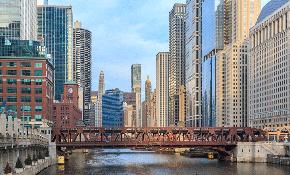 66% of the significant office building in Chicago have earned an Energy Star label, or a LEED certification.
66% of the significant office building in Chicago have earned an Energy Star label, or a LEED certification.
CHICAGO—After placing second last year, the Chicago market claimed the top spot in the fourth annual Green Building Adoption Index study by CBRE and Maastricht University. San Francisco slipped to second, while Atlanta, Houston and Minneapolis again claimed spots in the top five in the 2017 report. CBRE and Maastricht define “green” office buildings in the US as those that hold either an EPA ENERGY STAR label, USGBC LEED certification or both.
In the 30 largest US markets. 10.3% of all buildings surveyed are Energy Star labeled, while 4.7% secured LEED certifications, both slightly ahead of last year’s totals, although the total percentage of certified space fell slightly due to expiration of some certifications.
“Chicago has always been in the top three,” David Pogue, CBRE’s global director of corporate responsibility, tells GlobeSt.com, so grabbing the top spot with 66% of its surveyed space qualifying as green was not exactly a surprise. And although the city, like many of the top ten markets, enacted a bench-marking ordinance which requires owners to disclose energy use, he is not quite ready to “make a definitive correlation” between that and high performance.
Pogue attributes the proliferation of green buildings in a given metro area to community expectations, and municipal officials ready to encourage those attitudes. In addition, markets with a high proportion of corporate occupiers and institutional owners, as well as foreign investors, all groups that care deeply about environmental sustainability, tend to quickly adopt green building strategies.
“Chicago has all the elements that drive cities to high performance,” says Pogue.
This year’s study was the first to examine the potential impact of municipal energy disclosure regulations’ like Chicago’s on green adoption rates. Pogue points out that nine of the top 10 cities now have such ordinances. “These used to be considered odd, but now it’s an oddity if a major city doesn’t have one.” He wants to collect a few more years of data, but several markets have experienced measurable increases in green certifications. Cities with benchmarking ordinances have 9% more Energy Star and LEED certified buildings, and 21% higher Energy Star and LEED certified square footage. “This year’s findings do begin to establish a link that will be studied closely in the future.”
Cities with less institutional money and demand for green buildings may provide helpful data on these linkages, he adds. Kansas City, for example, just recently enacted a disclosure ordinance, and although it is less stringent than in some other cities, that may start pushing it up the rankings. The city is currently ranked 27th with less than four percent of its surveyed office buildings considered green. “Just the act of benchmarking your building helps you understand where you are in terms of energy use, and it moves people to do better.”
“Even though the current federal legislative agenda has shifted the focus away from energy efficiency and sustainability,” says Dr. Nils Kok, associate professor at Maastricht, “the momentum in the commercial real estate industry toward improving building operating performance and enhancing building quality is hard to derail.”

















 Copyright © 2024 ALM Global, LLC. All Rights Reserved.
Copyright © 2024 ALM Global, LLC. All Rights Reserved.